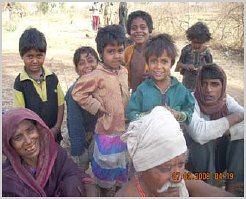(Report) BAHELIYAS- A hidden vulnerability of Bundelkhand region
BAHELIYAS- A hidden vulnerability of Bundelkhand region
By: Abhilash Nigam (Samvaad, New Delhi)
Introduction:
Panna Tiger Reserve:
Panna is the twenty-second Tiger Reserve of India and fifth in Madhya Pradesh. The Reserve is situated in the Vindhyan Ranges and spreads over Panna and Chattarpur districts in the north of the state. Panna National Park was created in 1981. Government of India declared it a Project Tiger Reserve in 1994. The National Park consists of areas from the former Gangau Wildlife Sanctuary created in 1975. This sanctuary comprised of territorial forests of the present North and South Panna Forest Division to which a portion of the adjoining Chhatarpur forest division was added later. The location of the National Park is also important because it is s. This area is also the northern most tip of the natural teak forests and the eastern most tip of the natural Kardhai (Anogeissus-pendula) forests. The Ken river, which flows through the Reserve from south to north, is home for Gharial and Mugger, and other aquatic fauna and is one of the least polluted rivers and a tributary of Yamuna. It is one of the sixteen perennial rivers of Madhya Pradesh and is truly the life-line of the Reserve.
Main Species : Mammals like Tiger, Jungle Cat, Leopard, Hyena, Wild Dog, Wolf, Sloth Bear, Sambhar, Chital, Nilgai, Chinkara, Chausinga, Porcupine, Jungle Cat, Rusty Spotted Cat, Hare, Ratel and Tree Shrew and Reptiles such as Long snouted crocodile (Gharial) and Marsh Crocodile (mugger) are found in the Ken river.
Baheliya community:
 Amongst broadly scattered forests in tiger reserve area of Panna district, there is a hidden community generally known as Baheliyaswhich is well defamed as destructor the wild lives and biodiversity of the region due to their involvement in poaching (hunting). Apart from this, fishing in Ken River, hunting of other animals and illicit removal of firewood, timber (mostly teak), NTFP (Mahua flowers, Beedi leaves, Medicinal Plants etc.) by this community is a continuous menace and puts regular pressure on Reserve resources. Commonly civil society, forest department, and administration identify this community as criminals and offenders due to their involvement in some unlawful acts.
Amongst broadly scattered forests in tiger reserve area of Panna district, there is a hidden community generally known as Baheliyaswhich is well defamed as destructor the wild lives and biodiversity of the region due to their involvement in poaching (hunting). Apart from this, fishing in Ken River, hunting of other animals and illicit removal of firewood, timber (mostly teak), NTFP (Mahua flowers, Beedi leaves, Medicinal Plants etc.) by this community is a continuous menace and puts regular pressure on Reserve resources. Commonly civil society, forest department, and administration identify this community as criminals and offenders due to their involvement in some unlawful acts.
Community resides:
1. Ajaygarh
2. Gandhigram
3. Shahnagar in Panna district
By observing their families, it appears that each family of this community has on an average 6 to 8 members. This community has been living around this area of national park for last 30 to 40 years. These people are extraterrestrial for rest of the society because of their living in impenetrable forests in an isolated way and involvement in hunting. Having a discussion with thirty five families in three different locations, they stated, "Poaching is our ancestral occupation but now it has been compulsion for us and we can’t d aythig else."
Habitat and Lifestyle:
Baheliyas do not make their permanent residence in some specific localtion. They are generally in itinerant condition in search of animals for hunting and wherever they think fit, they construct their temporary habitats with thatches, bamboo reeds, mud, and polythene and sometimes they stay in open spaces under the open sky. Generally, Baheliya community hides in some secret places inside the dense forests in order to commit poaching and to avoid action of forest guards. The
Baheliya community does notcollect household belongings as they do not have any land entitlement and they have to leave their place suddenly any time. They have no other business except wandering and hunting in forests especially at night. During daytime, they drink alcohol and sleep throughout the day. Some of their women and children go to nearby villages begging for flour and rice. In case they kill any animal, they cook its meat as their meal and sale fur, nails and other organs to Mafias in turn of which they get some money.
Livelihood Means:
The main source of livelihood for Baheliya community is illicit hunting of wild animals. They consider it as their ancestral occupation. In case of poaching, they are not only restricted to Panna tiger reserve but also they set out to other states’ forests within India with the help of concerned Smugglers and Mafias. Commonly, they live in groups and commit poaching collectively. After that, they put the killed animal’s fur and other organs to sale in turn of small amount from mediators or brokers. However, with the continuous reduction in number of fauna-flora and strict intervention made by national park authorities, the condition of hese families has turned to the worst. They are now suspected of engaging in some criminal activities also like theft, robbery, criminal mischief etc. and their women, and children have started begging which is an alarming situation for the society.
Download Full Report (PDF-200KB)...
Courtesy: Samvaad New Delhi.
- root's blog
- Log in to post comments